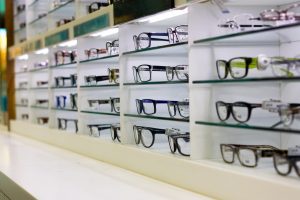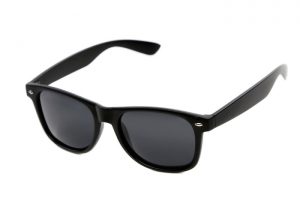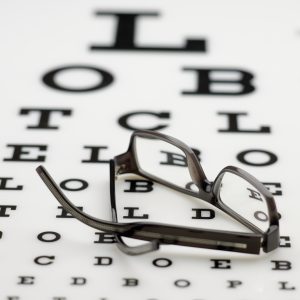Individuals over the age of 50 are at a higher risk for developing age-related macular degeneration (AMD), which causes gradual vision loss. If you are over the age of 50 and have noticed changes in your vision, call our office to schedule an appointment with your eye doctor to discuss your risk for AMD.
What is Macular Degeneration?
Macular degeneration is a condition in which the macula in the eye breaks down resulting in gradual central vision loss. This vision loss is commonly referred to as age-related macular degeneration due to its increased development in individuals over the age of 50. Early signs of this condition include shadows in your central vision, fuzzy vision, or distorted vision. While AMD is not curable, early detection, prevention, and treatment can help slow or stop the progression.
Symptoms of AMD
- Straight lines appear wavy
- Fuzzy vision
- Night vision problems
- Gray, dark, or empty area in central vision
- Dramatic vision loss
Types of macular degeneration
Dry macular degeneration is the most common type of AMD, diagnosed in nearly 90% of cases.* Dry macular degeneration causes yellowish deposits to form in the retina resulting in deterioration. Dry AMD will not result in full vision loss, but it is not curable or reversible. By maintaining good health and protecting your eyes from UV rays, you can decrease your risk and prevent early development of dry macular degeneration.
Wet macular degeneration is a severe form of AMD and accounts for about 10% of macular degeneration cases.* Wet AMD is an advanced form of macular degeneration and can result in full loss of central vision. Wet macular degeneration occurs when abnormal blood vessels grow under the retina and macula in the eye. As these blood vessels start to leak blood and fluid into the eye, the macula is forced to lift away from its base causing distorted central vision.
Who is at risk?
Macular degeneration primarily affects female Caucasians over the age of 50 people. While smoking is one of the highest risk factors for developing macular degeneration, other risk factors include obesity, high blood pressure, lighter eye color, and a family history of AMD.
If you are concerned about changes in your vision or suffer from one of these risk factors, call our office to schedule an appointment with your eye doctor and discuss your vision and risk of macular degeneration.
*American Macular Degeneration Foundation

 Navigating healthcare benefits and wellness perks can be tricky. Often the details are quite specific and involve websites or pamphlets than need to be studied to know what’s available to you. Flex Spending is one area that is often asked about, but under-utilized. It’s a great of an opportunity to save on necessary healthcare services and items.
Navigating healthcare benefits and wellness perks can be tricky. Often the details are quite specific and involve websites or pamphlets than need to be studied to know what’s available to you. Flex Spending is one area that is often asked about, but under-utilized. It’s a great of an opportunity to save on necessary healthcare services and items. Picking eyeglasses can be a difficult process of trial and error, especially if you haven’t done it many times before. The problem is that, unlike shopping for clothing where you may have a good idea of what fits you and what your favorite colors and patterns are, people can sometimes be vague on what they want for glasses (or have no idea at all). Few people know the most important factors for getting the right glasses for you: the shape of your face and which glasses will accent that shape, color and design options available to fit your preference, and features that will work best with your lifestyle.
Picking eyeglasses can be a difficult process of trial and error, especially if you haven’t done it many times before. The problem is that, unlike shopping for clothing where you may have a good idea of what fits you and what your favorite colors and patterns are, people can sometimes be vague on what they want for glasses (or have no idea at all). Few people know the most important factors for getting the right glasses for you: the shape of your face and which glasses will accent that shape, color and design options available to fit your preference, and features that will work best with your lifestyle. It’s the end of the week and you’ve only got a few hours left before the weekend. As you try to finish the last of your tasks, you find yourself unable to focus—not just mentally, but physically. You have trouble seeing the screen in front of you. Maybe your vision is blurry or your eyes start to burn. These are symptoms of computer vision syndrome.
It’s the end of the week and you’ve only got a few hours left before the weekend. As you try to finish the last of your tasks, you find yourself unable to focus—not just mentally, but physically. You have trouble seeing the screen in front of you. Maybe your vision is blurry or your eyes start to burn. These are symptoms of computer vision syndrome. When it comes to pediatric care, parents are usually concerned with finding the best pediatrician and following their medical advice exactly, but what about pediatric eye care? Eye care for kids is sometimes an area parents overlook because they aren’t always aware of the importance of eye health for children. Many don’t seek eye exams for their children until either the child reports having difficulty seeing at school, or the child’s grades begin to slip and parents take a closer look at why their child isn’t developing academically.
When it comes to pediatric care, parents are usually concerned with finding the best pediatrician and following their medical advice exactly, but what about pediatric eye care? Eye care for kids is sometimes an area parents overlook because they aren’t always aware of the importance of eye health for children. Many don’t seek eye exams for their children until either the child reports having difficulty seeing at school, or the child’s grades begin to slip and parents take a closer look at why their child isn’t developing academically. Squinting into the sun and focusing in bright light is very hard on your eyes. Eye care professionals stress the importance of sunglasses and shading your eyes to protect your vision, but many people aren’t aware of the benefits that come from polarized lenses. They’re not just for fishermen to see into the water!
Squinting into the sun and focusing in bright light is very hard on your eyes. Eye care professionals stress the importance of sunglasses and shading your eyes to protect your vision, but many people aren’t aware of the benefits that come from polarized lenses. They’re not just for fishermen to see into the water! Although it’s unlikely that demand for traditional glasses will ever disappear altogether (after all, they’re stylish, comfortable, and convenient), contact lenses have been popular for decades and continue to be a great choice for eyewear. From typical prescription options, to ones that change the color of the eye, to futuristic “smart” lenses—contacts have come a long way since 1888!
Although it’s unlikely that demand for traditional glasses will ever disappear altogether (after all, they’re stylish, comfortable, and convenient), contact lenses have been popular for decades and continue to be a great choice for eyewear. From typical prescription options, to ones that change the color of the eye, to futuristic “smart” lenses—contacts have come a long way since 1888! It seems like contact lenses and glasses would use the same prescription. After all, the idea is that your eyes don’t see quite right, so you use a lens to change the view, and then you see clearly, right? Well, the two prescriptions are quite different. Few patients check the numbers or notice any change during the exam process, but the prescriptions are not the same because of where the lens sits in relation to your eye.
It seems like contact lenses and glasses would use the same prescription. After all, the idea is that your eyes don’t see quite right, so you use a lens to change the view, and then you see clearly, right? Well, the two prescriptions are quite different. Few patients check the numbers or notice any change during the exam process, but the prescriptions are not the same because of where the lens sits in relation to your eye. Spring has arrived! The birds are chirping, the days are getting longer, and suddenly you’re experiencing itchy and watery eyes. Seasonal allergies affect an estimated 50 million people in the United States, making the spring season a little (or a lot) less pleasant for many Americans. Up to 30 percent of adults and up to 40 percent of children report having problems with seasonal allergies. That’s no small amount of people with itchy eyes and runny noses!
Spring has arrived! The birds are chirping, the days are getting longer, and suddenly you’re experiencing itchy and watery eyes. Seasonal allergies affect an estimated 50 million people in the United States, making the spring season a little (or a lot) less pleasant for many Americans. Up to 30 percent of adults and up to 40 percent of children report having problems with seasonal allergies. That’s no small amount of people with itchy eyes and runny noses! Taking care of your eyes includes more than going to a yearly exam and wearing an up-to-date prescription. Although both are certainly important, there are many more things you can (and should) do to make sure you’re preventing eye problems and protecting your vision.
Taking care of your eyes includes more than going to a yearly exam and wearing an up-to-date prescription. Although both are certainly important, there are many more things you can (and should) do to make sure you’re preventing eye problems and protecting your vision.